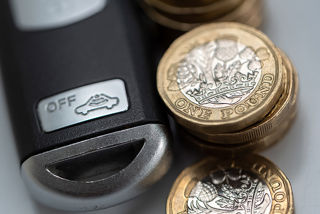The dramatic change in the CO2 emissions make-up of the company car fleet has been illustrated by newly published data from HM Revenue and Customs (HMRC).
In the tax year 2002/03, more than half of the company car fleet (58%) had emissions values in excess of 165g/km. Ten years later, that had fallen to just 9%.
Between 2011/12 and 2012/13 – the tax years for which HMRC statistics have just been made available – the number of company cars emitting less than 145g/km increased by 20% and cars emitting more than 145g/km decreased by 32%.
Drill down further and almost half (43%) of the fleet have CO2 emissions of 124g/km or less, with more than a fifth (21%) emitting between 115-124g/km. Just 2% of company cars (20,000 units) had emissions of less than 95g/km.
HMRC data also shows that about 81% of company cars use diesel fuel, with 19% using petrol. Looking back to 2002/03, only 33% of company cars used diesel.
Mixed fortunes for fleets
However, while the emissions make-up and fuel type of the company car fleet has changed, the data shows the overall number of company cars on UK roads has remained at the same level for the past two years.
The newly-published provisional figures for the 2013/14 tax year reveal that benefit-in-kind (BIK) tax was paid on a total of 940,000 company cars – the same figure for 2012/13.
While that total represents a 10,000-car fall on 2011/12, it suggests numbers have stabilised after a steady decline since the company car peak recorded in 1999/2000 when 1.16 million people paid BIK tax on a car, according to HMRC.
However, despite this overall stability, new data from the Lex Autolease Report on Company Motoring 2015 suggests differing fortunes for fleets.
It says quarter of fleets (26%) have reported a reduction in the number of vehicles they operate during the past year, while more than a third (38%) said their fleet had grown over the same period.
This, says Lex Autolease, reflects the mixed picture of the economic recovery – also highlighted in the newly published Fleet News Fleet200 survey of Britain’s biggest fleets.
However, when HMRC’s company car figure is compared to fleet registrations of new cars from the Society of Motor Manufacturers and Traders (SMMT), the numbers at first don’t appear to stack up.
The SMMT reported 1,178,416 fleet registrations in 2014, compared to a provisional figure from the HMRC of 940,000 employees paying company car tax during the tax year 2013/14.
The HMRC figure remained unchanged between 2012/13 and 2013/14, yet fleet registrations climbed by 8.7% from 2013 to 2014, according to the SMMT.
Part of the problem is what the SMMT classes as ‘fleet’. With a typical annual new car market of 2m, fleet accounts for just over half, but of those 1.18m new cars, around 220,000 go to Motability.
A further 230,000 are daily rental, while captives account for around 70,000.
‘True fleet’ accounts for the rest, generally between 650,000 and 700,000.
These are believed to be genuine, new company car registrations, although true fleet also includes cars registered as courtesy cars to bodyshops – estimated at around 45,000.
Annual true fleet registrations of 600,000 would suggest a fleet of 1.8m company cars on a three-year cycle, or 2.4m cars on a four-year cycle.
Both are considerably higher than HMRC’s figure of 940,000 company cars. This could be down to a similar number of vehicles to the HMRC figure being used purely for business, with no private use, which would negate BIK being paid and exclude them from the HMRC total, including pool cars.
Critical recruitment tool
What is clear, however, is the company car remains a critical recruitment tool, with 64% of company car drivers saying it would be an important factor in their decision to take a new job or not.
Receivng a company car is also seen as a mark of achievement by 45% of company car drivers and 32% of employees with private cars, according to Lex Autolease’s report, which draws on the experiences of 249 fleet managers and more than 1,000 employees.
Results from the survey paint a positive picture for the fleet sector, according to Tim Porter, managing director of Lex Autolease. He says the leasing company’s research highlights how the car remains one of the “most cost and tax-effective ways of recruiting and retaining the best staff”.
“New car sales are now higher than before the recession and many fleet managers are reporting that their fleets are growing strongly,” he added.
“It is clear that the car remains a vital tool for work and is also a highly valued employee benefit.”
Fewer grey fleet drivers paid more than AMAP rate
The number of grey fleet drivers being paid more than the Government approved mileage rate has almost halved in the past five years.
In 2008/09, there were 560,000 employees being paid more than the Approved Mileage Allowance Payments (AMAP) rate, but by 2013/14 – just five years later – that had fallen to 290,000, according to HMRC.
The number of recipients of taxable excess mileage allowance payments held steady until 2009-10, with a slight fall in 2010-11 from 550,000 to 510,000 and then a much larger one (to 380,000) in 2011-12.
From April 2011, the Approved Mileage Allowance Payments (AMAPs) rate was increased from 40p to 45p per mile (ppm) for the first 10,000 miles of business travel in a tax year. This meant that drivers receiving mileage allowances in excess of AMAP were charged tax and national insurance contributions (NIC) on the difference between the payment offered by their employer and 45p, rather than 40p. Employees receiving AMAPs at a rate of between 40-45ppm no longer needed to report their benefit, or pay tax or NIC on it. Further decreases since the change was introduced have been caused by a number of employers, in particular local authorities, who reduced mileage allowances, says HMRC.
Fall in ‘free’ fuel continues, but still provided to 200,000 drivers
The number of employees receiving so-called ‘free’ fuel has fallen by more than a third (39%), HMRC figures suggest.
Yet the taxable value has only fallen by 15% over the same period, from £870m in 2007/08 to £740m in 2013/14.
HMRC suggests that the reduction in recipients for car fuel benefit is a likely reflection of rising fuel prices, causing employers and employees to look more carefully at whether the fuel benefit formula results in a tax charge commensurate with the true value of the benefit.
Almost a quarter of company car drivers (200,000) continue to use fuel paid for by their company in private use.
But virtually all would save money by giving up the ‘perk’ (Fleet News, June 25, 2015).
“There are very few circumstances where both the employee and employer will be financially better off by retaining the benefit,” David Rawlings, director of BCF Wessex Consultants and a former automotive tax expert at Deloitte, told Fleet News. Car fuel benefit represented 10% of the total taxable value of all benefits in kind, according to HMRC.


















Login to comment
Comments
No comments have been made yet.